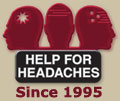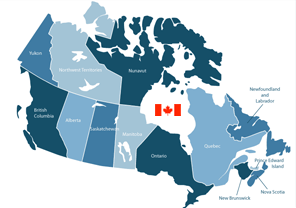Below I have listed a number of categories for you to compare. Sometimes you will notice how you have a few features of one category mixed with a few symptoms of another category. These are clues to mention to your doctor in case you have multiple headache conditions.
The work you do ahead of time and in between appointments can often lead to answers surfacing with tips for techniques and treatments.
Ask yourself the following questions:
- Are my headaches beginning for the first time?
- Are they predictable - eg. time of day, location, triggers, storm fronts, hormonal?
- Are there family histories of migraines or headaches? Are they hereditary?
- Am I using any non-pharmacological techniques? Vitamins? Herbs? (Please tell your physician)
- What makes them worse? What makes them better?
- Do they respond to Medicines? Alternatives? Self-Help Techniques?
- What am I taking now for them? (Over-the-Counter remedies, Triptans, Motrin, Tylenol, Aspirin, Advil?)
Migraine Without Aura (Common Migraine)
Usually this is a one-sided very painful headache, which can last 4-72 hours. Migraine without Aura is severe in intensity and is often (75%) seen in women who are usually in their child-bearing years. It is a pulsating or throbbing sensation of pain. 70% of sufferers often have a family history of migraine. Sometimes common migraines can be brought on by a food, weather or stress "trigger" - but a trigger is not the same thing as a cause. Common migraine is a biological problem that can affect anyone. Changes in brain chemistry produce neurological and physical symptoms. These symptoms and sensations are important to learn and record as that is how physicians diagnose migraine. Due to a broad range of symptoms among sufferers, it is recommended to consult with a headache physician and pharmacist on a regular basis. These migraine headaches are often mild to moderate in pain severity, and they often present themselves as severe.
Migraine With Aura (Classic Migraine)
Migraines that are preceded by neurological warning signs are often referred to as Migraine with Aura. The aura that suggests that the migraine is on its way is characterized by symptoms such as flickering lights or black spots in the field of vision. Wavy, zig zag lines characteristic of a spider web can be present in the field of vision also. Occasional numbness on one side of the face or hand can also occur, suggestive of an aura. The headache pain following the aura is typically a one-sided headache with a throbbing or pounding sensation of pain, often signifying migraine with aura. The aura, a warning sign that this category of migraine is on its way, is experienced in about 15% - 19% of people suffering with migraines. They experience changes in brain function that can seem strange or bizarre. It is common for sufferers to experience neurological symptoms such as difficulty speaking, imbalance, vertigo, loss of consciousness and paralysis or numbness. Visual symptoms such as a blind spot in the field of vision are the most common features. Sometimes the headache associated with this migraine type might be very mild or even absent. These types of migraines can be mild to moderate in severity and are often severe in their pain quality. Migraine with aura is not completely understood, but there are effective medical treatments available. Consult with a physician and sometimes with a neurologist with interest in headaches.
Tension-type Headache
Tension-type headaches are the most common type of headache and are found in over three-quarters of headache patterns. They have been reported as a headache condition felt on both sides of the head and are described as tight, non-pulsating, pressing or squeezing band-like pain. As muscles tighten in the head and neck and blood vessels in the head expand, headache pain is often experienced on the forehead or on both sides of the head. The pain can be experienced as a "tight-hat" sensation or a pressing, squeezing sensation of pain. The location of the pain often moves, covering the temples, crown, front or back of the head and neck. Unlike migraine, this headache type is usually not aggravated by daily routine. Some experts argue that tension-type headache pain is actually a variant of migraine pain. Tension headaches were once labeled as a psychological cause for head pain by some sufferers. Today we know changes in brain chemistry often induce a Tension-Type Headache. Almost everyone suffers occasionally from muscle contraction headaches (an older name once used). In its chronic form it represents a painful annoyance, and is referred to as a Chronic Tension-Type Headache which can be very stubborn to treat for both the sufferer and by a headache physician. For more information on Chronic Tension-Type Headache see the book 'Headaches That Persist'. Care should be taken not to over-medicate and cause Medication Overuse Headaches known formerly as Rebound Headaches.
Cluster Headache
A "Cluster Headache" is arguably the most sinister of all headache types. Cluster headache sufferers are often disproportionately male, whereas migraine tends to be more prominent in females. One-sided headache attacks come in bouts or a series of pain, which is why these headache types are called "clusters". A teary eye on the affected side is common as well as a drooped eyelid on the affected side. Also, running of the nose or nasal discharge has been recorded. The pain duration of cluster headache is typically 1-3 hours, whereas migraine is generally 7 hours or more. Cluster headache sufferers are in so much pain that sufferers typically bang their heads on the wall, in total frustration. Direct oxygen has been an effective relief for some sufferers as well as many other medications. For some extreme cases even surgery is recommended by a physician. Often medications are used to avert an attack or to prevent further subsequent attacks. A number of medications can be used to successfully treat cluster headache.
For additional resources go to www.clusterheadaches.com
A very similar headache condition to cluster and sometimes easily confused is a headache condition known as Hemicrania Continua - see Chronic Daily Headache article in 'Headaches That Persist'.
In cluster headache both the episodic type (described above) and the chronic cluster headache type (Chronic Daily Headache) are listed. In the episodic form there are generally cycles or bouts of recurring headaches that occur for 3-4 months at a time, sometimes longer or shorter, and then go into a remission (holiday) in which there will be no headaches present for months, or longer.
The chronic form may start as a chronic headache, without any prolonged period of headache absence, or it may evolve from the seasonal, episodic type.
Chronic cluster headache is fully explained in Chronic Daily Headache.
Autonomic features often associated with Cluster Headaches are:
- Redenning and tearing of the eye
- A runny or blocked nostril
- Droopy eyelid
- Constriction of the pupil
- Flushing and facial sweating
For more information on Cluster Headache visit OUCH UK.
Medication Overuse Headaches
(formerly Rebound Headache or Medication-Induced Headache)
Many sufferers develop "Medication Overuse Headaches" from taking too much pain medicine, too often. The daily or frequent use of over-the-counter (OTC) medicines can often lead to this condition. Researchers suggest medication with caffeine or ergotamine are particularly at fault.
These headaches are usually mild to moderate in severity of pain and may have migraineous associated features. They can be variable but often daily in occurance and sufferer's may experience this type of headache 2-3 times per week.
The pain associated with medication overuse headache is a pressing, dull, diffuse pain that is typically felt all over the head (much like tension-type). Medication overuse headaches are usually worse in the morning hour and often can be felt on the front or top of the head. Typically, a cycle of medication use, followed by partial headache relief, followed by another headache, can be suggestive to medication overuse headache. Sufferers notice increased medication use with a decreased results.
Sinus Headache
True sinus headache will show up on an x-ray and the sufferer will experience a yellow-green discharge from their nasal area. Migraine headaches are often confused as sinus headaches as the pain of migraine often gets referred to areas of the face, including the ear, nose and jaw, at times. Please see the article on www.headache-help.org/free articles - sinus headache, for further explainations.
Post-Traumatic Headache
(headaches after head injuries)
Not necessarily a benign headache condition, Headache after Head Injuries can often commence after a fall or injury thus giving it the name Post-Traumatic Headache. Once the concussion or head injury heals often the headaches will disappear. Typically, the sufferer will experience a dull, diffuse pain felt on both sides of the head.
In many cases of post-traumatic headache the neck is more significantly involved and may be the cause of the sustaining headache. The headache may be chronic, and then the term ‘chronic post-traumatic headache’ is used, when that evolves.
There is a full article on Headaches After Head Injuries in 'Headaches That Persist.
Rare Headaches
Rare headaches can be secondary to some underlying disease or medical ailment. Usually, once the condition is stopped - the secondary headache goes away.
Some examples of rare headaches may include:
Ice Cream Headache
An ice cream headache can also be referred to as a cold stimulus headache. At times, with headache sufferers, putting cold ice cream on the roof of your tongue can produce a headache. The same term is used for a headache arising from a cold object in the back of the throat near or by the soft palate. Ice cream is simply one food item that can cause this headache type. Again, avoiding that trigger would be the fastest solution to living a pain-free life.Migraine Equivalents (Migraine without the headache)
This type of headache can feature neurological symptoms or non-neurological symptoms, such as abdominal pain, vertigo, even emotional outbursts, depression or panic. The word equivalent suggests that sufferers instead of a headache, are having some other equivalent troubling symptom. This condition is much more common in children and can resemble stroke-like symptoms which are a numbness or tingling on the arm - absent of any headache which can often be referred to as a migraine equivalent. Also younger children often complain of an upset stomach - absent of any headache. This can often also be a migraine equivalent. Once the child has thrown up, there is often an easing up and relief of the headache symptoms. This headache type is experienced in the stomach which just happens to be the location where a lot of the neurotransmitter serotonin is located.
Hotdog Headache
Nitrites that are often found in hotdogs, gives this rare headache the name "hotdog headache". Nitrites are powerful triggers and can cause blood vessels to swell, thus causing a headache. The nitrites found in hotdogs are responsible for this headache type. It is important to understand that any sandwhich or processed meat that contains nitrites can also produce a ‘hot dog headache’. If nitrites were your headache trigger the easiest solution would be to use trigger-avoidance whenever possible.
Reviewed by Dr. Joel Saper, Michigan Headache & Neurological Institute, Ann Arbor, Michigan. Dr. Joel Saper further reviewed the section on rare headaches.

